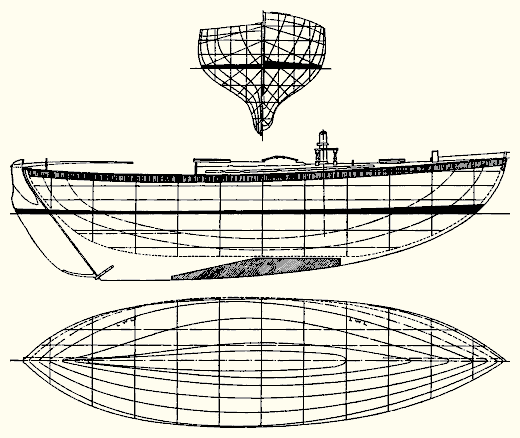
| Fram A 39' Double-Ended Sloop By William Atkin |
| The Double-Ender Fram | |
| The double-ended auxiliary Fram was designed to fill the requirements of many of MoToR BoatinG's readers. It may be interesting to know that ever since the publication of the plans of the double-ender Thistle several years ago, letters have come asking for more plans of this wholesome type of boat. And if you will look through back numbers you will find plans of boats of this type. Offhand there comes to mind the names of Eric, Jr., Mink, Ingrid, Thistle, Little Ranger, and Eric. These range in over-all length from 25 feet to 42 feet, and are recognized as comfortable, able, and fine sailing craft. As I have remarked many times before, there is a lot to be said for the double-ender. Not only are boats of this model perfectly balanced; they are inherently strong; grand sea-goers; cheaper to build; and comfortable. | |

| |
Fram is 39 feet 0 inches over-all length; 34 feet 2 inches water line; 10 feet 2 1/2 inches breadth; 5 feet 6 inches draft. The freeboard at the bow is 4 feet 7 1/2 inches; at the lowest point, 3 feet 2 inches; at the stern, 3 feet 8 inches. The displacement is 27,500 pounds. There is 11,800 pounds of outside ballast; 1,000 pounds inside ballast. The above figures are based on lead being used for the keel. If iron is used the keel (if made to dimensions shown on plans) it will weigh 7,500 pounds; in this case inside ballast will weigh 5,300 pounds. Fram is rigged as a sloop. The sail area is 891 square feet; distributed as follows: main sail 595 square feet; staysail, 135.8 square feet; jib, 180.5 square feet. The rig is tall and short on the base; not excessive and conforming with current practice as rigs go nowadays. The mast is simply stayed including permanent backstay. Expensive deck and rigging equipment have been eliminated in an effort to keep the building price within reason. | |

| |
The cabin of Fram is arranged to accommodate a party of four. There is full six foot headroom for practically the full length. The forward stateroom is fitted with two pipe berths, sail lockers, chain locker, seat and lockers for clothes and supplies. The main cabin is 8 feet long and outfitted nicely with sofas having box berths. There are long lockers behind the box berths for stowing blankets, linen, etc., and two buffets fitted with drawers and lockers. A drop leaf table is fixed to the floor in front of the port sofa. The floor space between the sofas measures 3 feet 2 inches and is level for its full width. Here is one of the advantages of the wide keel and generous width through the garboards. The galley is 6 feet 6 inches long and contains a coal range, sink, work table, dish lockers, and lockers for food and equipment. The ice box is on the opposite side and is very large in capacity. The toilet room is 4 feet 4 inches long and contains the usual equipment. Fram is of raised deck type; but with continuous sheer line; the drop in the deck is hidden behind the bulwark rail. This form makes a very strong structure and provides lots of room in the cabin. This arrangement is less costly than the more usual deck house type. While the raised deck has many advantages, it also has disadvantages, not least of which is the difficulty of getting light and ventilation for the cabin, both of which must come through the deck, since port lights are not practicable in the topsides of a boat as small as Fram. However, there is always something to upset the apple cart. | |

| |
The lines of Fram are my development of the double-ender. Eric, Jr., Ingrid, and Eric show the influence of Colin Archer and the North Sea types: Little Ranger and Fram the influence of my designs for Tally Ho! and TallyHoMajor, yachts designed for cruising in U. S. waters. A study of the body plans of these five designs by me shows the sectional characteristics of the Colin Archer and Atkinized double-ender. The under water profile of the Atkinized lines show proportionally less draft than the Colin Archer model and a keel profile that is unbroken in its curvature from forward point of the water line to the bottom of the stern post; more drag and less forefoot. Comparing results of performance of yachts built to the older and the newer models, the latter have proved the better from every angle; ever so much better, I might add. The motor is installed under the bridge deck and cockpit floor. The motor is splayed to the port hand. The propeller, however, is in the center of the stern post. The advantage of this arrangement is easy steering when the boat is under power; no pull on the tiller as would be the case with straight center line drive. | |
| Plans for Fram are $250 MYSTIC SEAPORT MUSEUM SHIPS PLANS STORE https://store.mysticseaport.org/ships-plans/ shipsplanstore@mysticseaport.org
+1 (860) 572 5360 | |
| BACK TO PLAN LIST | |